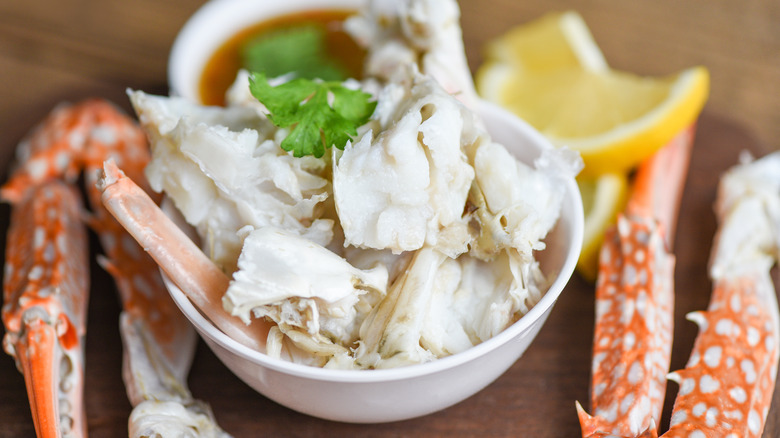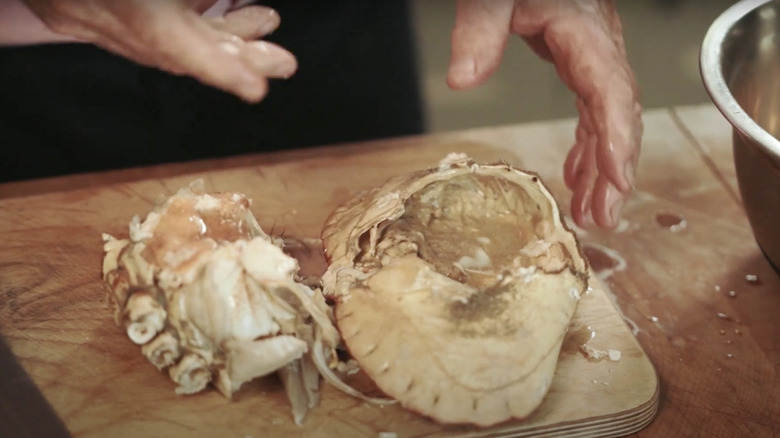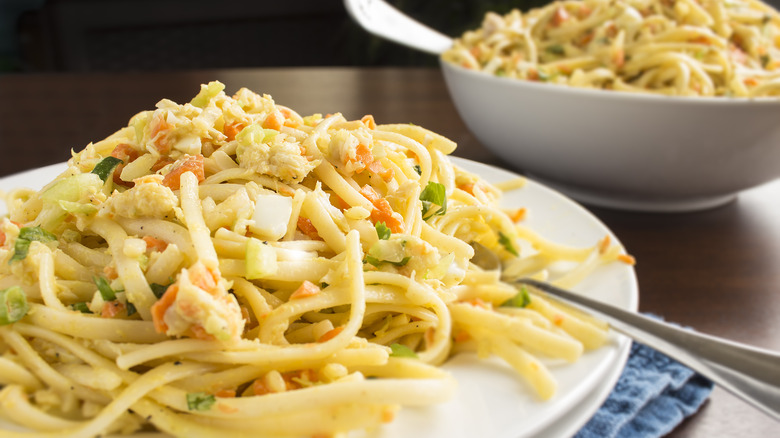White Vs Brown Crab Meat: What's The Difference?
Who doesn't love crab doused in butter and a squeeze of lemon juice? As seafood connoisseurs know, there are numerous types — blue crab, snow crab, Dungeness crab, and ultra-expensive king crab. But did you know that there are also different kinds of crab meat as well — specifically white and brown crab meat? While this might remind you of how poultry is split into light and dark meat, that analogy isn't entirely correct, as the difference between brown and white crab meat is distinctive.
White crab meat is what most people think of when shopping or ordering at a restaurant. Low in fat, this meat makes up much of the appendages of a crab. You can find it in the crab's legs, claws, and its main body section where its appendages connect. White crab meat gets its name from the distinctively snow-like color it turns when cooked — unlike imitation crab meat.
Meanwhile, brown crab meat, as it is commonly referred to in Europe and the U.K., exclusively comes from the shell cavity of the crab itself, meaning you'll only get this meat if you buy a crab whole. However, brown crab meat isn't meat in a traditional sense. It's made up of a mixture of different glands and organs such as the liver or reproductive organs. As such, it's high in fat and Omega-3s and varies in size depending on the crab's molting stage. When it comes to cooking and taste, the two types of meat couldn't be more different.
How to cook brown crab meat
When it comes to the texture of brown crab meat, it's often a mixture that's gooey and paste-like, similar to a pâté or potted meat. Remember, brown meat is made of mostly organs and glands so you'll get a smoother, mushier feel. As far as taste, you should expect an intense savoriness, with some sweetness and brininess that's best paired with other ingredients. By itself, the flavor may not be to everyone's taste. For this reason, overall, brown crab meat is typically incorporated into dishes (in sauces, for instance) rather than being served on its own. To wit: You can combine brown crab meat with butter and lemon juice for a sauce for your fish and other seafood.
Likewise, layer some brown crab meat on a toasted bun with some olive oil, diced tomatoes, and cheese for a seafood take on a bruschetta. Of course, the main way many people enjoy brown crab meat is mixed up with white crab meat. It gives the latter a bit more depth and complexity. To mix up the two crab meats, all you need to do is make sure all of your brown crab meat is a fine mush. Layer in the white meat, but remember to be gentle with the delicate crab. Don't break up all of your white meat as you will want it to be a bit chunky. From there, you can add the mixture to a salad or pasta.
How to cook white crab meat
Compared to brown crab meat, white crab is much more versatile when it comes to both cooking and taste. The exact taste and texture of white crab meat will vary depending on what type of crab you're eating. For instance, snow crab meat is sweet and delicate, while king crab meat is heartier, almost similar to lobster. Comparatively, blue crab is salty and has a flaky texture. In general, white crab meat is milder than brown crab meat but has a sturdier texture.
This makes it the perfect ingredient for all kinds of dishes. For instance, consider mixing in white crab meat with some pasta noodles and veggies for a hearty but filling dinner. Break out the cream cheese and chives and incorporate white crab meat for a delicious crab dip appetizer. Likewise, white crab meat makes for delicious crab cakes, which you can drink with beer, wine, or even cocktails. Unlike brown crab meat, white crab meat can also be served by itself without much fuss. Just break out the lemons and your best grocery store butter for melting. Of course, if you feel your white crab meat is a bit too plain, you can always mix it with brown crab meat for some added oceanic intensity.


